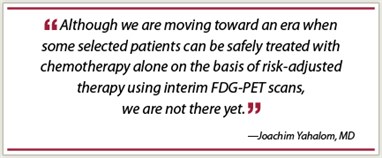 The Canadian HD.6 randomized study in patients with nonbulky early-stage Hodgkin lymphoma is mostly of historic interest.1,2 It has little relevance to current treatment standards or questions, and the risk for its inappropriate interpretation is of great concern.
The Canadian HD.6 randomized study in patients with nonbulky early-stage Hodgkin lymphoma is mostly of historic interest.1,2 It has little relevance to current treatment standards or questions, and the risk for its inappropriate interpretation is of great concern.
Radical Radiation Approach Long Abandoned
The study evaluated three treatment programs (see article beginning on page 1); two of these programs have been abandoned at most centers for almost 2 decades. Indeed, the National Cancer Institute of Canada closed HD.6 earlier than planned (in 2002), recognizing that it was testing treatment strategies that were no longer considered appropriate.
The radiation field in these programs was sub–total nodal irradiation (STNI) to 35 Gy. STNI included all lymph nodes sites in the upper body (bilateral neck, full mediastinum with hilar areas, and both axillae), whether they were involved with Hodgkin lymphoma or not. It continued with radiation to the clinically uninvolved spleen and abdominal lymph nodes. Many organs were unnecessarily irradiated. This field was shown in multiple randomized and nonrandomized studies to be unwarranted and potentially toxic.
The total/subtotal nodal radical radiation approach was designed more than 50 years ago, when in the absence of effective and relatively safe chemotherapy for Hodgkin lymphoma, radiation was primarily used alone. For almost 20 years, it has become highly exceptional to use STNI, either alone or, particularly, in combination with chemotherapy.
It should be underscored that STNI bears no resemblance to the currently practiced limited radiation field called involved-field radiotherapy. During the past decade, even smaller and more precise involved-node radiotherapy fields have been defined and are used in many combined-modality programs. These limited fields irradiate roughly only around 10% of the STNI volume, and they include merely the tissue volume containing the originally involved lymph nodes with tight margins. Furthermore, involved-field or involved-node radiotherapy nowadays is administered more precisely, owing to the progress in advanced imaging and modern radiotherapy techniques, and in lower doses (20 or 30 Gy).
Radiation-related long-term risks are a function of field size, organs included, and dose. Not surprisingly, several studies with long follow-up have already demonstrated that the toxicity and long-term risk profile of involved-field radiotherapy is markedly reduced in comparison to the known risks of the obsolete extensive radiation field used in HD.6.
Lessons from Mortality and Second Cancers in HD.6
The authors and interpreters of HD.6 grouped together the cohort that received STNI alone (their more favorable group) with the less favorable cohort that received two courses of ABVD (doxorubicin, bleomycin, vinblastine, and dacarbazine) followed by STNI. They often call all these patients together the “radiation therapy group.” Interestingly, these two groups had different mortality risk profiles, although both achieved excellent disease control. STNI-alone patients had excellent survival, with only one death from any cause, and obtained excellent disease control, with an overall survival rate of 98%.
In contrast, most early or late mortality events—a total of 23—occurred in the less favorable group (older patients, more disease sites, mixed-cellularity histology) that received ABVD combined with excessive radiation (STNI). Thus, in spite of significantly superior disease control provided by adding STNI in comparison to ABVD alone, even after doubling or tripling the ABVD dose (HR = 3.2; P = .006), mortality events were more common than in the group that received only ABVD (11 events), resulting in a better overall survival (P = .04) for the ABVD-alone group—the main message of this study.
Unexplained Anomaly
An unexplained anomaly from this study is the finding that one STNI group was so safe and the other was not. Unfortunately, some important information regarding mortality and second cancers was not provided. A key analysis that needs to be performed is to determine the number of second cancers that were within the radiation field and, furthermore, how many cancers were in the involved sites. The latter is particularly important as it allows a fairer comparison with the current standard-of-care therapy that limits radiation to the involved field. Information on what types of second cancers were included in the mortality events is also missing.
Yet, from the limited information in the New England Journal of Medicine paper,2 some intriguing observations can be made—namely, that all mortality events (n = 5) titled “others” have peculiarly occurred only in the ABVD/STNI cohort. These events included Alzheimer’s disease, accidental drowning, and suicide. In addition, three deaths “related to infection” were again noted only in the ABVD/STNI arm. Perhaps these deaths were related to unnecessary irradiation of the spleen in STNI, but in practice, it is extremely rare to see lethal infections related to radiation of Hodgkin lymphoma. The number of deaths from cardiac events was identical in both arms; deaths from Hodgkin lymphoma were also similar (five in the ABVD arm, four in the ABVD/STNI arm).
The remaining difference in mortality in this study is from second tumors (four in the ABVD arm, nine in the ABVD/STNI arm). The list of second malignancies is revealing, and many of those listed in the “radiation therapy” column (n = 23) are most unlikely to be related to radiation of sites in the upper part of the body. These include six tumors in the pelvis, and it is difficult to understand how they could even be related to STNI (bladder, rectum, cervix, prostate, etc). Leukemia cases (n = 2) were only seen in the STNI group. These events are rare even with total nodal radiation and clearly are not seen with ABVD and involved-field radiotherapy. Seven other tumors have unclear relationships to the radiation field. In fact, among the reputably radiation-related cancers, tumors of the lung and breast were reported in a single patient each, and the ABVD-only group had the same number of each.
In a study that had significantly fewer events than it was statistically designed for, and that insinuates that the “radiation” reversed its obvious and highly significant benefit in disease control by causing excessive mortality, attention to the specific events and their possible relationship to any radiation or to mere coincidence is even more important. Information is missing on which second cancers caused death, but from the data presented, it seems likely that omitting deaths that could not be attributed to radiation—and in particular not to modern supradiaphragmatic radiotherapy—the number of deaths among patients with an unfavorable risk profile would be the same in both arms of the study.
Toward Individualized Treatment
HD.6 confirms once again that the long-ago decision of lymphoma experts to restrict the radiation field in a combined-modality setting was correct. Yet, it would be wrong to conclude from this study that “radiation” of any kind should be omitted and six cycles of ABVD alone (or four in some) as used in HD.6 is the best way to go.
The authors are content that this approach yielded an overall survival of 87%, but other treatment programs like the German Hodgkin Study Group (GHSG) HD10 trial achieved an overall survival of 97% with only two cycles of ABVD and involved-field radiotherapy of 20 Gy. Why should we settle for an inferior outcome with more systemic therapy? And why use data from a radiation approach that is more extensive by several magnitudes and obviously more toxic? Unnecessarily increasing the total exposure to ABVD has significant acute and late toxicity associated with it. The dose-related cardiac and pulmonary toxicity of ABVD is well documented and is troublesome.
 The ability to salvage with bone marrow transplantation many chemotherapy-alone failures that could have been avoided with limited radiotherapy brings only relative comfort to approximately 15% of patients with nonbulky, early-stage disease who will still require salvage after chemotherapy alone. They still have to deal with tough treatment, sterility, enhanced short- and long-term toxicity risk, and disruption of their young lives. It would be of interest to know where the failures with ABVD alone were. As in all other similar studies, most relapses were probably at the sites of original disease and thus could have been avoided with limited radiotherapy.
The ability to salvage with bone marrow transplantation many chemotherapy-alone failures that could have been avoided with limited radiotherapy brings only relative comfort to approximately 15% of patients with nonbulky, early-stage disease who will still require salvage after chemotherapy alone. They still have to deal with tough treatment, sterility, enhanced short- and long-term toxicity risk, and disruption of their young lives. It would be of interest to know where the failures with ABVD alone were. As in all other similar studies, most relapses were probably at the sites of original disease and thus could have been avoided with limited radiotherapy.
Although we are moving toward an era when some selected patients can be safely treated with chemotherapy alone on the basis of risk-adjusted therapy using interim FDG-PET scans, we are not there yet. Now we rely on clinical judgment to estimate the benefit/risk ratio of a certain approach. For example, we will avoid irradiating an axilla (and with it part of the breast) in a young woman who has had a complete remission by PET. Yet, most other patients will extract the best benefit, even if rendered PET-negative, from less-intensive ABVD therapy supplemented with reduced radiation field and dose.
Unfortunately, negative PET after chemotherapy alone has not yet provided us with the security that we hoped for. The EORTC/GELA/IIL HD10 randomized study that looked into this question of safe omission of radiotherapy had to close the chemotherapy-only arms because of too many relapses. Perhaps better interpretation of PET-negative scans or emergence of other predictive imaging and molecular tests will help in the future.
In the meantime, we should offer early-stage, highly curable patients therapy that combines mini-ABVD with miniradiotherapy, like the German HD10 and HD11 trials, and avoid outdated therapies like STNI or long courses of ABVD alone. We have already been doing better than that. ■
Disclosure: Dr. Yahalom reported no potential conflicts of interest.
References
1. Meyer RM, Gospodarowicz M, Connors JM, et al: Final analysis of a randomized comparison of ABVD chemotherapy with a strategy that includes radiation therapy in patients with limited-stage Hodgkin lymphoma: NCIC CTG/ECOG HD.6. 53rd Annual Meeting of the American Society of Hematology. Abstract 590. Presented December 12, 2011.
2. Meyer RM, Gospodarowicz M, Connors JM, et al: ABVD alone versus radiation-based therapy in limited-stage Hodgkin’s lymphoma. N Engl J Med. December 11, 2011 (early release online).
Dr. Yahalom is Chairman, International Lymphoma Radiation Oncology Group; Coleader of the Lymphoma Disease Management Team, Attending Radiation Oncologist, and Member, Memorial Sloan-Kettering Cancer Center; and Professor of Radiation Oncology, Weill Cornell Medical College, New York.

